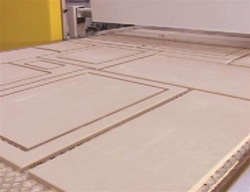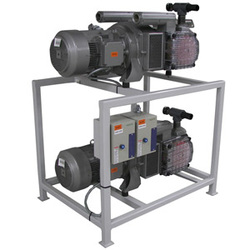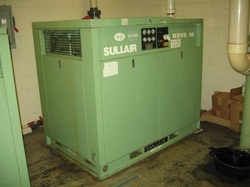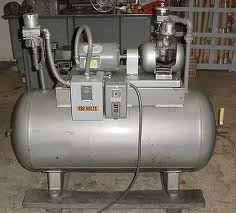Will You Need a Flat Bed or a Pod and Rail System?

The top photo shows a flat table with movable pods while the photo in this section shows a "pod & Rail" system. While both systems have movable pods the "pod & Rail" system will not allow a full sheet of plywood to be cut into numerous parts.
While the Pod & Rail system will allow for large flat parts like entry way doors or large cabinet doors and side panels the pods will need to be positioned into exact locations and small enough to hold down the smallest finished part and in sufficient quantity to hold all the parts.
Typically a "nested" sheet will have as many as 12 or 15 parts and typically part location from sheet to sheet will vary greatly, so much so, that finding pod location from sheet to sheet with a pod and rail system would take much to long to arrange for each sheet even if the part sizes were not an issue.
While the Pod & Rail system will allow for large flat parts like entry way doors or large cabinet doors and side panels the pods will need to be positioned into exact locations and small enough to hold down the smallest finished part and in sufficient quantity to hold all the parts.
Typically a "nested" sheet will have as many as 12 or 15 parts and typically part location from sheet to sheet will vary greatly, so much so, that finding pod location from sheet to sheet with a pod and rail system would take much to long to arrange for each sheet even if the part sizes were not an issue.
"Nesting" is a Process where Vacuum is Pulled through Raw MDF board to hold down Flat Stock.

If your production is 100% flat material like plywood or laminated MDF or laminated particle board you may never need to worry with the pods of any fashion. This makes your decision process somewhat easier as the kind of pump you need is determined only by the size of your sheets and the smallest parts you need to process.
However, if you have the kind of production that requires that you cut large flat sheets like plywood and the processing of solid wood parts with large edge profiles you will need to incorporate a universal table design and some type of pods to be determined by the complexity of your parts.
If you are going to be using pods you will also need to incorporate some strategy to locate your pods on the table in exact locations and then you will need to incorporate some strategy to locate your raw parts atop the pods in a precise manner to insure the location of the tool path on your parts.
You can see "pins" in the top photo on the bottom and to the left and right. Its important that these pins move away from the cut path after the raw material is situated atop of the pods to prevent "crashing" the tool into the pins.
However, if you have the kind of production that requires that you cut large flat sheets like plywood and the processing of solid wood parts with large edge profiles you will need to incorporate a universal table design and some type of pods to be determined by the complexity of your parts.
If you are going to be using pods you will also need to incorporate some strategy to locate your pods on the table in exact locations and then you will need to incorporate some strategy to locate your raw parts atop the pods in a precise manner to insure the location of the tool path on your parts.
You can see "pins" in the top photo on the bottom and to the left and right. Its important that these pins move away from the cut path after the raw material is situated atop of the pods to prevent "crashing" the tool into the pins.
The Type of Vacuum System You Need Greatly Effects What Pump you Need & the Configuration.

To get a handle on the part hold down requirement of your CNC you will need to define the type and complexity of your parts. I start with understanding if your parts need to be held up in the air for any reason.
Solid wood parts, solid surface parts and many office furniture top or dinning room table tops need to up off of the table to allow for larger size tools to profile the bottom edge of the parts.
The pods shown in both of the first photos in this section, will allow for lifting the parts but there is a significant difference between these pods, can you see the difference?
The pods in the top photo has 1/4" hoses laying on top of the table to get vacuum to the pods and the pods in the photo for this section do not. Instead these pods get vacuum from under the table. We call this a universal spoil board, which also allows for nesting parts with out pods by using MDF "spoil boards".
Solid wood parts, solid surface parts and many office furniture top or dinning room table tops need to up off of the table to allow for larger size tools to profile the bottom edge of the parts.
The pods shown in both of the first photos in this section, will allow for lifting the parts but there is a significant difference between these pods, can you see the difference?
The pods in the top photo has 1/4" hoses laying on top of the table to get vacuum to the pods and the pods in the photo for this section do not. Instead these pods get vacuum from under the table. We call this a universal spoil board, which also allows for nesting parts with out pods by using MDF "spoil boards".
Now you may Begin to Determine the Type of Vacuum Pump you will Require.

The vacuum pumps pictured to the left are the most popular type of pump used on a wide selection of CNC Routers and Point to Point boring machines.
These are called "rotary vein" pumps. This type of pump provides for a high flow of air (typically 200 to 250 cubic Meters / hour) and a very high vacuum possibility.
I would say it is the best pump of the highest number of applications.
There are applications where this pump will not work or just is not needed and they are as follows:
The first application where this type of pump will not work is when you require more air to flow to hold down your parts. As with the case shown in this photo, this customer stacked two identical pumps on top of one another to increase the air flow. In this case the customer divided their 5' x 10' table into two areas and hooked one pump to each area, doubling the air flow. If you require more than 500 Cubic Meters per Hour you will require a bigger pump.
The Second application, not recommended for this pump, is for pods only or where dedicated spoil boards are used.
In this case, you simple will not need as much air flow as these pumps provide and it would be a waste of energy.
These are called "rotary vein" pumps. This type of pump provides for a high flow of air (typically 200 to 250 cubic Meters / hour) and a very high vacuum possibility.
I would say it is the best pump of the highest number of applications.
There are applications where this pump will not work or just is not needed and they are as follows:
The first application where this type of pump will not work is when you require more air to flow to hold down your parts. As with the case shown in this photo, this customer stacked two identical pumps on top of one another to increase the air flow. In this case the customer divided their 5' x 10' table into two areas and hooked one pump to each area, doubling the air flow. If you require more than 500 Cubic Meters per Hour you will require a bigger pump.
The Second application, not recommended for this pump, is for pods only or where dedicated spoil boards are used.
In this case, you simple will not need as much air flow as these pumps provide and it would be a waste of energy.
Higher Air Flow & High Pressure can be Achieved by "Rotary Screw" type Pumps.

Quincy or Sullair are just two companies that can provide more air flow also with high vacuum levels.
Applications that may require 15hp to 50hp pumps like this would be nesting applications where the parts are very small or in applications where the parts being cut are out of raw particle board or raw MDF.
In one application, cutting raw particle board, I had to recommend a 75hp pump to insure the parts did not move during the cut.
A software feature called "tabbing" has helped with this application and when holding down small parts.
Applications that may require 15hp to 50hp pumps like this would be nesting applications where the parts are very small or in applications where the parts being cut are out of raw particle board or raw MDF.
In one application, cutting raw particle board, I had to recommend a 75hp pump to insure the parts did not move during the cut.
A software feature called "tabbing" has helped with this application and when holding down small parts.
High Vacuum Pressure with Low air flow.

This is an example of a pump that is often found on much older machines typically with use on "dedicated" spoil boards for part hold down.
However, if you have an application where you will have a very high number of the exact same part you may choose to use a dedicated spoil board. It does take about 30 min. to change the spoil boards but if you are going to run the same parts for more than a few hours it may be a benefit to run this type of low energy, low noise and low maintenance pump.
Another application may be that you are able to use "pods" exclusively for part hold down then this type of pump will work very well.
However, if you have an application where you will have a very high number of the exact same part you may choose to use a dedicated spoil board. It does take about 30 min. to change the spoil boards but if you are going to run the same parts for more than a few hours it may be a benefit to run this type of low energy, low noise and low maintenance pump.
Another application may be that you are able to use "pods" exclusively for part hold down then this type of pump will work very well.
1 You must not:
(a) use our website in any way or take any action that causes, or may cause, damage to the website or impairment of the performance, availability or accessibility of the website;
(b) use our website in any way that is unlawful, illegal, fraudulent or harmful, or in connection with any unlawful, illegal, fraudulent or harmful purpose or activity;
(c) use our website to copy, store, host, transmit, send, use, publish or distribute any material which consists of (or is linked to) any spyware, computer virus, Trojan horse, worm, keystroke logger, rootkit or other malicious computer software;
(d) [conduct any systematic or automated data collection activities (including without limitation scraping, data mining, data extraction and data harvesting) on or in relation to our website without our express written consent];
(e) [access or otherwise interact with our website using any robot, spider or other automated means[, except for the purpose of [search engine indexing]]];
(f) [violate the directives set out in the robots.txt file for our website]; or
(g) [use data collected from our website for any direct marketing activity (including without limitation email marketing, SMS marketing, telemarketing and direct mailing)].
[additional list items]
5.2 You must not use data collected from our website to contact individuals, companies or other persons or entities.
5.3 You must ensure that all the information you supply to us through our website, or in relation to our website, is [true, accurate, current, complete and non-misleading].
(a) use our website in any way or take any action that causes, or may cause, damage to the website or impairment of the performance, availability or accessibility of the website;
(b) use our website in any way that is unlawful, illegal, fraudulent or harmful, or in connection with any unlawful, illegal, fraudulent or harmful purpose or activity;
(c) use our website to copy, store, host, transmit, send, use, publish or distribute any material which consists of (or is linked to) any spyware, computer virus, Trojan horse, worm, keystroke logger, rootkit or other malicious computer software;
(d) [conduct any systematic or automated data collection activities (including without limitation scraping, data mining, data extraction and data harvesting) on or in relation to our website without our express written consent];
(e) [access or otherwise interact with our website using any robot, spider or other automated means[, except for the purpose of [search engine indexing]]];
(f) [violate the directives set out in the robots.txt file for our website]; or
(g) [use data collected from our website for any direct marketing activity (including without limitation email marketing, SMS marketing, telemarketing and direct mailing)].
[additional list items]
5.2 You must not use data collected from our website to contact individuals, companies or other persons or entities.
5.3 You must ensure that all the information you supply to us through our website, or in relation to our website, is [true, accurate, current, complete and non-misleading].
